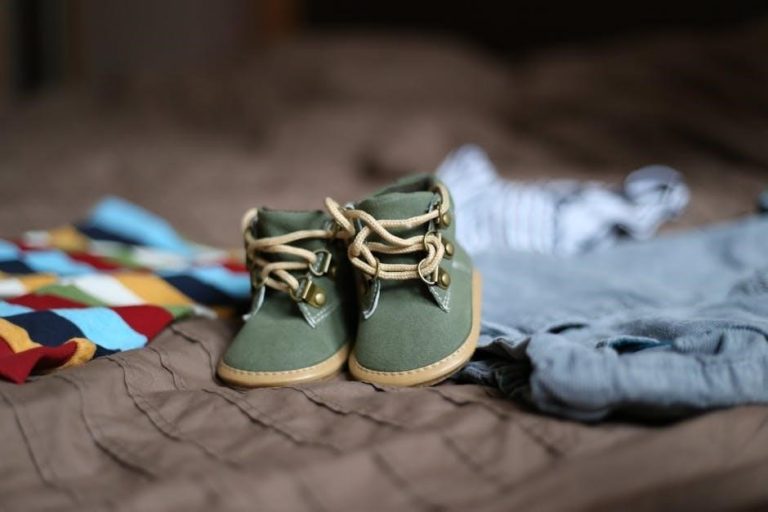How to Measure Your Baby’s Feet for the Perfect Shoe Size
To measure your baby’s feet for the perfect shoe size, place the foot on a flat surface, mark the longest toe and heel with a ruler, and measure the length. Use a printable size chart or brand-specific guide to determine the corresponding shoe size, ensuring a proper fit for comfort and development. Always measure while standing and wearing socks for accuracy.
Using a Ruler or Printable Size Chart
Place your baby’s foot on a flat surface and trace the outline. Measure the longest toe and heel using a ruler. Compare the length to a printable size chart to determine the shoe size. Ensure accuracy by measuring both feet, as they may differ. Use the chart’s guidelines to match the foot length to the corresponding size. This method provides a reliable starting point for selecting the right shoe size.
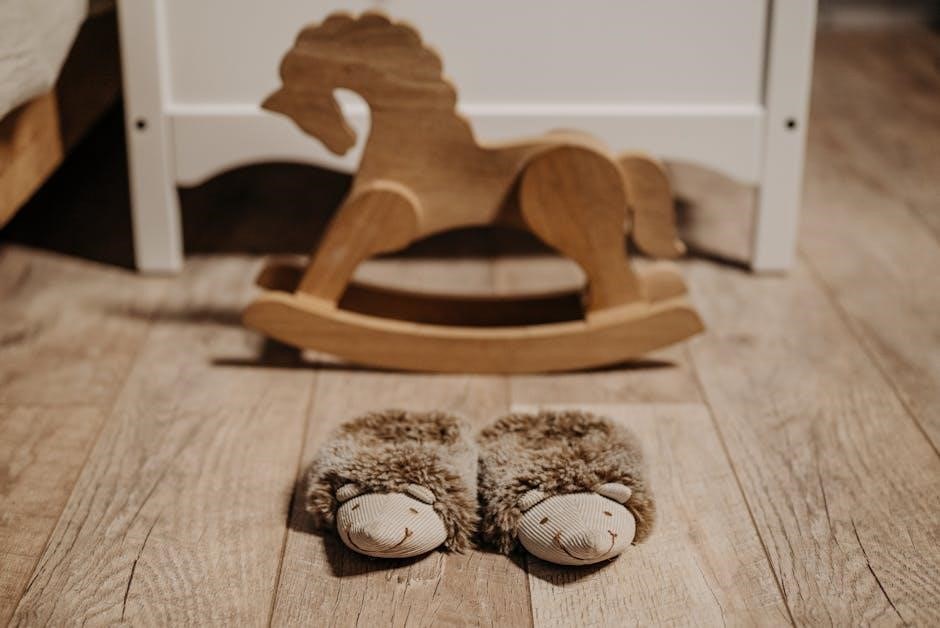
Measuring While Standing and Wearing Socks
Measure your baby’s feet while standing to ensure accuracy, as this captures the foot’s full length when bearing weight. Have your baby stand on a flat surface, wearing the same socks they’ll use with the shoes. Trace the outline of the foot or use a ruler to measure from the longest toe to the back of the heel. This method ensures the shoes will fit comfortably over the socks, providing enough room for growth and proper foot development.
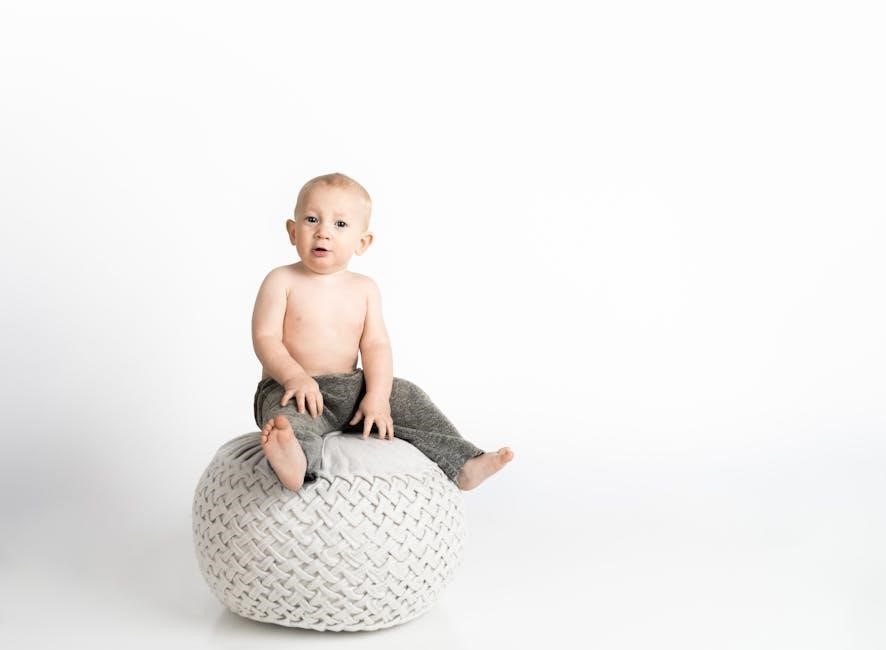
Understanding Baby Shoe Size Charts
Baby shoe size charts link foot length to specific sizes, helping parents choose the right fit. Charts vary by brand, so always refer to the brand’s guide for accuracy.
US Baby Shoe Size Chart by Foot Length and Age
The US baby shoe size chart aligns foot length in inches with age ranges. Newborns (0-2 months) typically wear size 0.5-1.5C, corresponding to 3.25-3.5 inches. Infants (3-6 months) are around 3.5-4 inches, fitting sizes 2-2.5C. As babies grow, sizes increase, with toddlers (12-24 months) ranging from 4.5 to 6 inches, fitting sizes 4-6C. Always use this chart as a guide and measure feet for the best fit, as growth rates vary.
Converting Foot Length to Shoe Size
To convert your baby’s foot length to the correct shoe size, measure the foot while standing and wearing socks for accuracy. Use a ruler or printable chart to determine the length. Align this measurement with a US baby shoe size chart, where each size corresponds to a specific foot length. For example, a 4-inch foot typically fits a size 3.5C. Always refer to brand-specific charts, as sizes may vary, and consider leaving room for growth. This ensures a comfortable and proper fit, supporting healthy foot development.

Factors Affecting Baby Shoe Size
A baby’s age, growth rate, and foot shape influence shoe size. Rapid growth during infancy means frequent size adjustments. Foot length is the primary factor, but width and toe shape also matter. Socks thickness and brand-specific sizing can affect fit. Always measure feet while standing for accuracy, as this ensures the best fit for comfort and proper foot development.
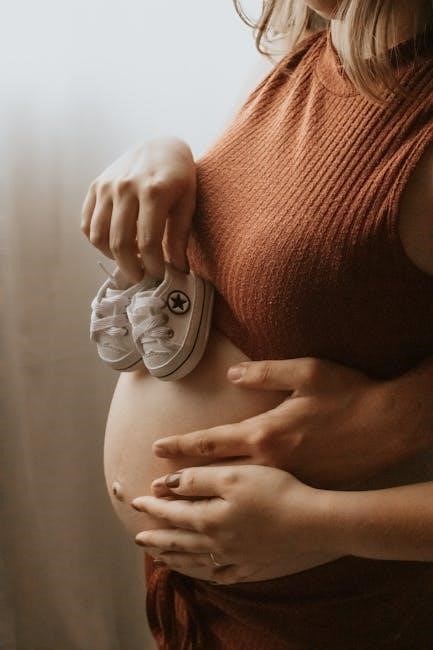
Baby’s Age and Foot Growth Rate
Baby shoe sizes correlate roughly with age, as rapid growth occurs during infancy. A 0-3 month old typically wears size 1, while a 6-9 month old may need size 2 or 3. Growth rates vary, so regular measurements are essential. On average, babies grow two to three shoe sizes per year, making frequent checks crucial for ensuring proper fit and comfort. Always measure feet while standing for accuracy.
Importance of Proper Fit for Development
A proper fit is crucial for healthy foot development and comfort. Ill-fitting shoes can cause discomfort, blisters, or even foot deformities. Soft-soled shoes are ideal for infants, allowing natural foot movement and muscle development. As babies grow, transitioning to harder soles around 24 months supports stability during walking. Properly fitted shoes prevent issues like ingrown toenails or bunions, ensuring healthy growth and comfort as your baby explores the world.
How Baby Shoe Sizes Correlate with Age
Baby shoe sizes roughly correlate with age, as infants grow quickly. For example, a 0-3 months old may wear size 1, while a 3-6 months old might wear size 2. Sizes increase with age, but individual foot measurements are essential for accuracy.
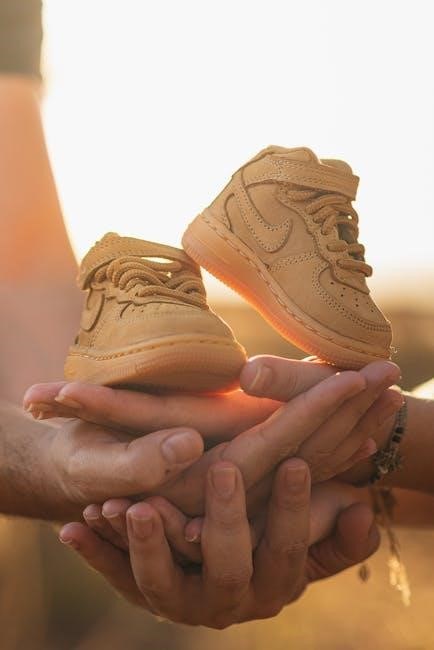
Infant Shoe Sizes (0-12 Months)
Infant shoe sizes range from 0 to 6, corresponding to foot lengths of 3 to 4.5 inches. Newborns (0-2 months) typically wear size 0.5-1.5, while older infants (6-12 months) may need sizes 3-4. Growth rates vary, so measuring feet regularly is essential. Use a size chart to match foot length to the correct size, ensuring a comfortable fit. Brands may slightly differ, so always consult their specific size guides for accuracy.
Toddler Shoe Sizes (1-3 Years)
Toddler shoe sizes typically range from 4 to 10, corresponding to foot lengths of 4.5 to 6.5 inches. Sizes may overlap with infant categories, and measuring is crucial as growth spurts vary. Use a size chart to match foot length to the correct size, ensuring comfort and proper fit. Some brands offer half sizes for toddlers, providing a better fit during rapid growth phases. Always consult brand-specific guides for accuracy.
Choosing the Right Baby Shoe Size
Measure your baby’s feet accurately using a ruler or size chart. Ensure proper fit by leaving room for growth and checking brand-specific sizing guides for comfort and support.
Tips for Trying Shoes On
When trying shoes on your baby, ensure they wear the same socks they’ll use with the shoes. Measure and mark foot length beforehand. Check for proper fit by pressing gently at the toe box—there should be about 1/2 inch of space. Avoid tight fits, as they can hinder foot development. Let your baby stand to ensure comfort and support. Choose shoes with soft, breathable materials for optimal comfort and growth.
Leaving Room for Growth
Always leave about 1/2 inch of space between the longest toe and the shoe tip to accommodate growth. Babies’ feet grow rapidly, and tight shoes can cause discomfort or hinder development. Ensure the shoe is snug but not restrictive, allowing natural movement. Regularly check fit as your baby grows, especially during the first 3 years when foot growth is fastest. Proper spacing ensures comfort and supports healthy foot development.
Why Proper Fit Matters
A proper fit ensures comfort, supports healthy foot development, and prevents discomfort or blisters. Ill-fitting shoes can hinder growth and cause long-term foot issues for your baby.
Supporting Foot Development
Properly fitted shoes are essential for healthy foot development in babies. Shoes that are too tight can restrict growth and cause deformities, while overly loose shoes may lead to blisters and instability. Ensuring a snug yet comfortable fit allows toes to move naturally, promoting strong muscle and bone development. Refer to size charts and measure regularly to accommodate rapid growth, as ill-fitting shoes can hinder proper foot formation and function.
Preventing Discomfort and Blisters
Properly fitted shoes are crucial to prevent discomfort and blisters on your baby’s feet. Ill-fitting shoes can cause friction, leading to painful blisters and soreness. Ensure shoes are neither too tight nor too loose, allowing toes to move freely. Soft-soled shoes are ideal for younger babies, while older toddlers may benefit from shoes with breathable materials to reduce moisture buildup. Always check for signs of irritation and adjust sizes as needed for comfort.
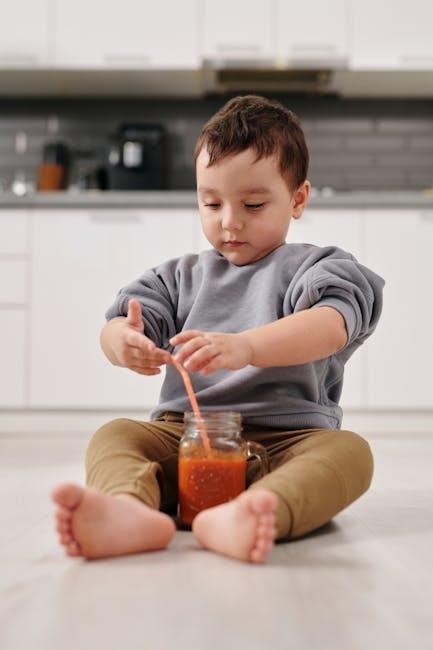
Differences in Baby Shoe Sizes by Brand
Baby shoe sizes vary by brand, with some offering half sizes for better fit. Brands like Carter’s provide size charts, ensuring accurate measurement for foot length and age.
Brand-Specific Size Charts
Brand-specific size charts are essential for accurate shoe fitting. Each brand tailors its chart to foot length and age, ensuring a precise fit. For example, Carter’s offers half sizes for toddlers, while Stride Rite provides detailed size finders. Jack & Lily includes two size options for better accuracy. Always consult the brand’s specific guide, as sizes can vary. Measure both feet and use the longer measurement for the best fit.
Half Sizes for Toddler Shoes
Half sizes for toddler shoes provide a better fit during growth spurts. Brands like Carter’s offer half sizes in walking shoes, ensuring comfort and proper support. These sizes accommodate foot growth, preventing tight fits and discomfort. Always measure your toddler’s feet regularly, as growth rates vary. Half sizes are especially useful for toddlers transitioning to harder soles, offering a snug yet roomy fit for developing feet.
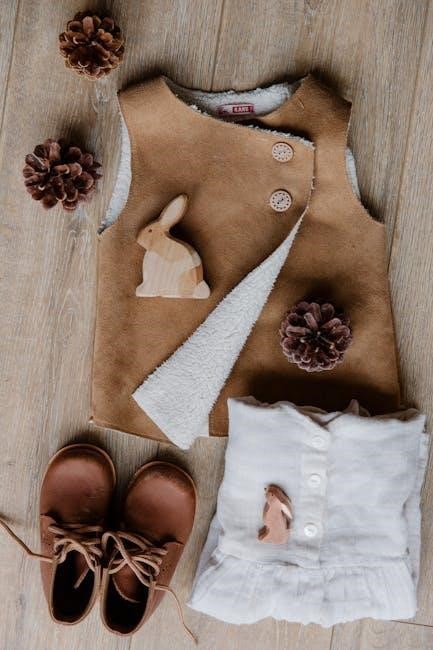
When to Use Soft-Soled Shoes
Soft-soled shoes are ideal for infants and early walkers, typically up to 24 months, as they provide flexibility and protection while supporting natural foot development. Transition to harder soles as needed.
Age Recommendations
Soft-soled shoes are recommended for infants and toddlers up to 24 months, as they support natural foot development and provide flexibility for early walkers. Pediatricians suggest bare feet for development, but when shoes are needed, soft-soled options are ideal for comfort and growth. Transition to harder soles as the child becomes more confident and ventures onto varied surfaces, typically around 2 years of age.
Transitioning to Harder Soles
Transitioning from soft-soled shoes to harder soles is essential as your baby becomes a more confident walker. Typically recommended around 24 months, harder soles offer enhanced support and protection for exploring varied surfaces. Opt for durable materials like rubber or leather for outdoor durability while ensuring comfort and breathability. Refer to shoe size charts for proper fit, allowing toe movement and growth. Consult pediatric guidelines for a smooth transition, balancing protection, support, and comfort.
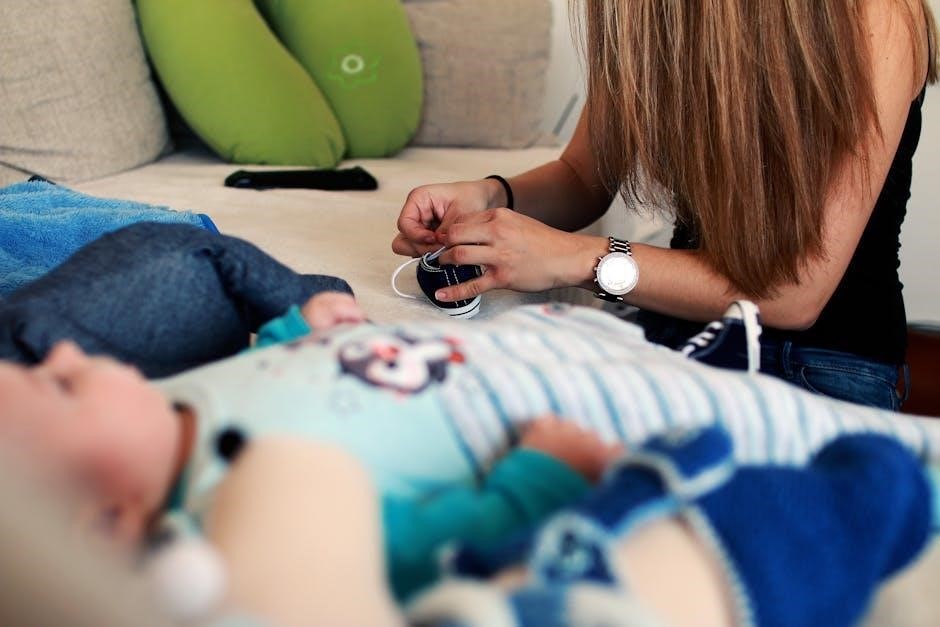
A Parent’s Guide to Buying Baby Shoes
Measure your baby’s feet using a ruler or printable chart. Choose shoes with breathable materials and soft soles for comfort. Ensure proper fit by leaving room for growth and trying shoes on while wearing socks. Refer to brand-specific size guides for accuracy and support foot development with the right style for their age and activity level.
Step-by-Step Shopping Tips
- Measure your baby’s feet using a ruler or printable chart to ensure accuracy.
- Use brand-specific size guides to match foot length to the correct shoe size.
- Try shoes on while your baby is standing and wearing the same socks they’ll use with the shoes.
- Check for a snug but comfortable fit, leaving about 1/2 inch of room for growth.
- Opt for soft, breathable materials to support foot development and comfort.
- Consider the style based on your baby’s activity level, such as soft-soled shoes for pre-walkers.
- Refer to brand-specific charts for half sizes or toddler-specific fits if needed.
When to Size Up
Regularly check your baby’s shoe fit as their feet grow rapidly. Measure every few months using a ruler or printable chart while standing and wearing socks. Ensure about half an inch of room for growth. If shoes feel tight, cause discomfort, or your baby seems uneasy, it’s time to size up. Consider brand-specific charts for accurate sizing and observe comfort during walking. Size up when shoes are snug or show signs of wear, ensuring proper fit for development and comfort.
